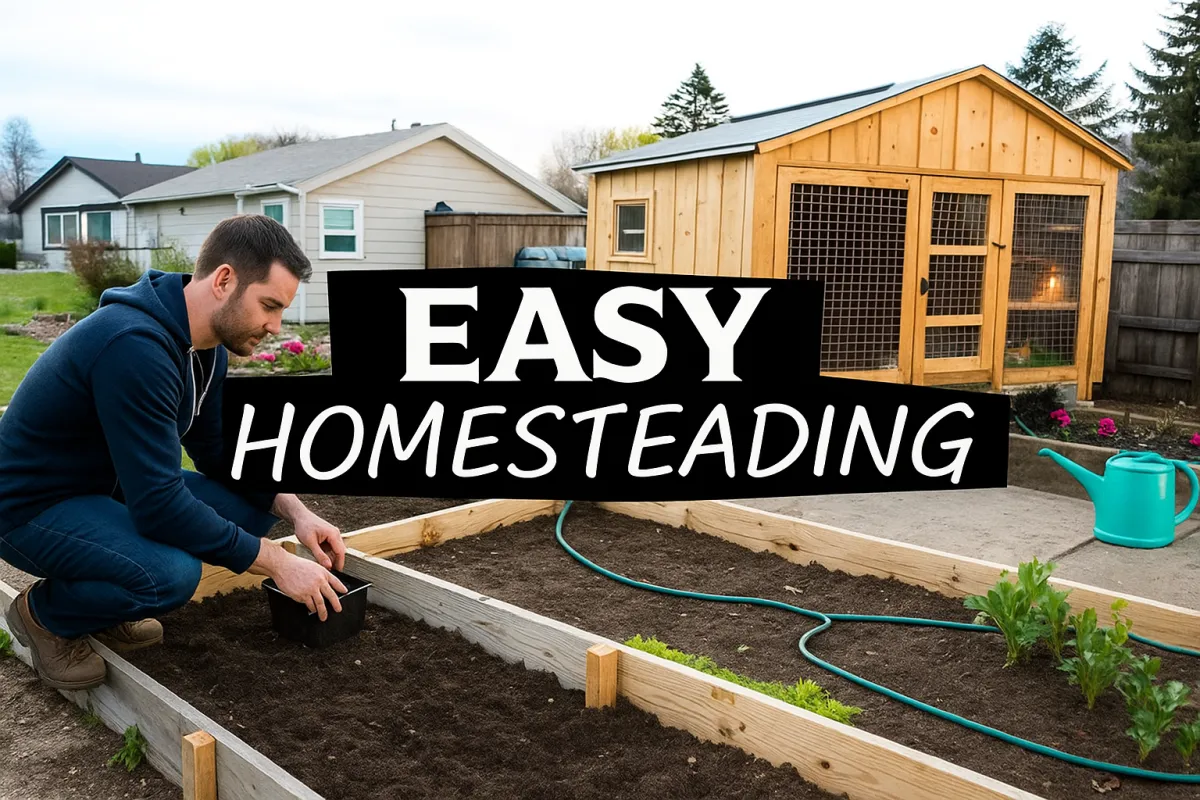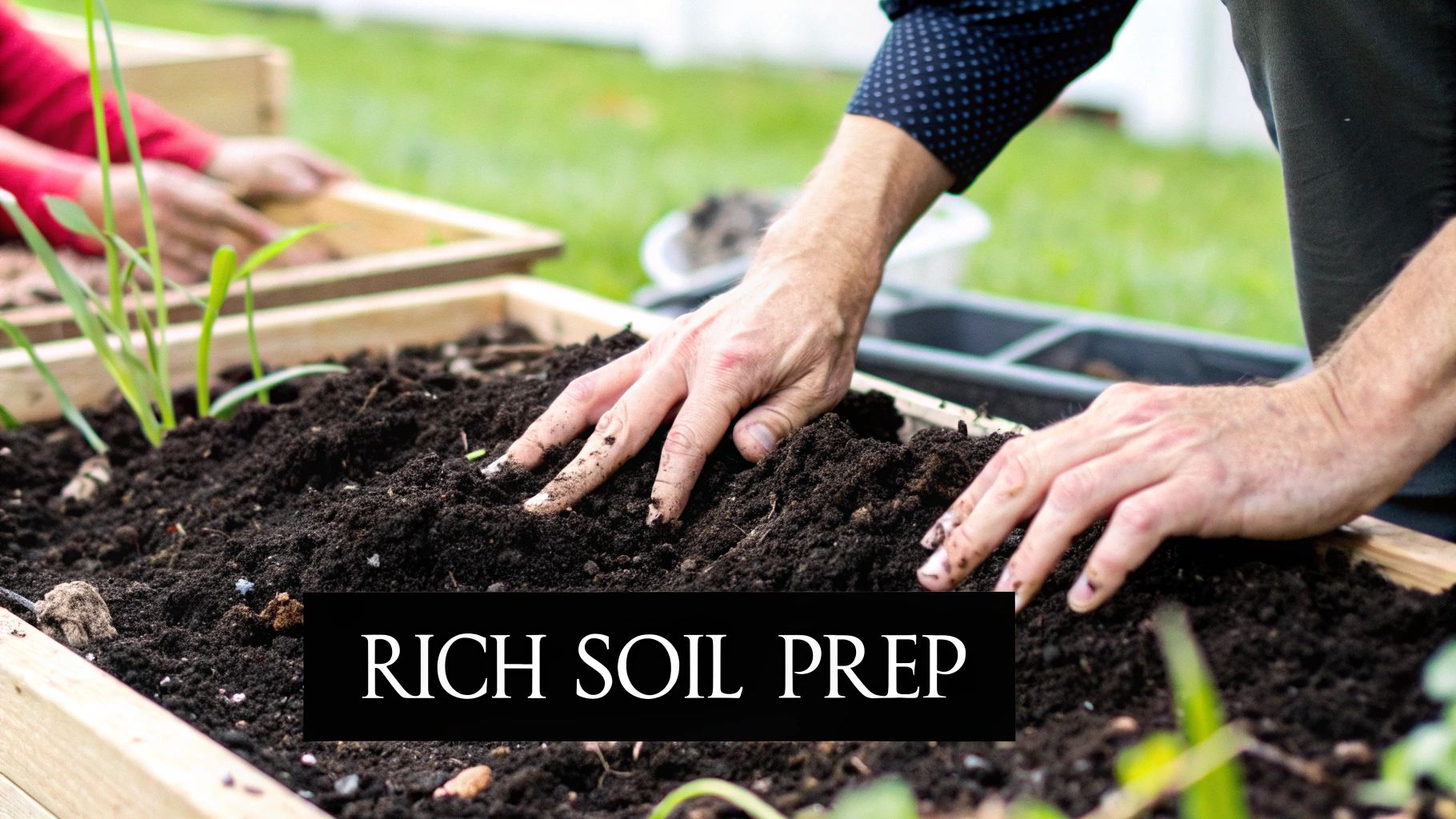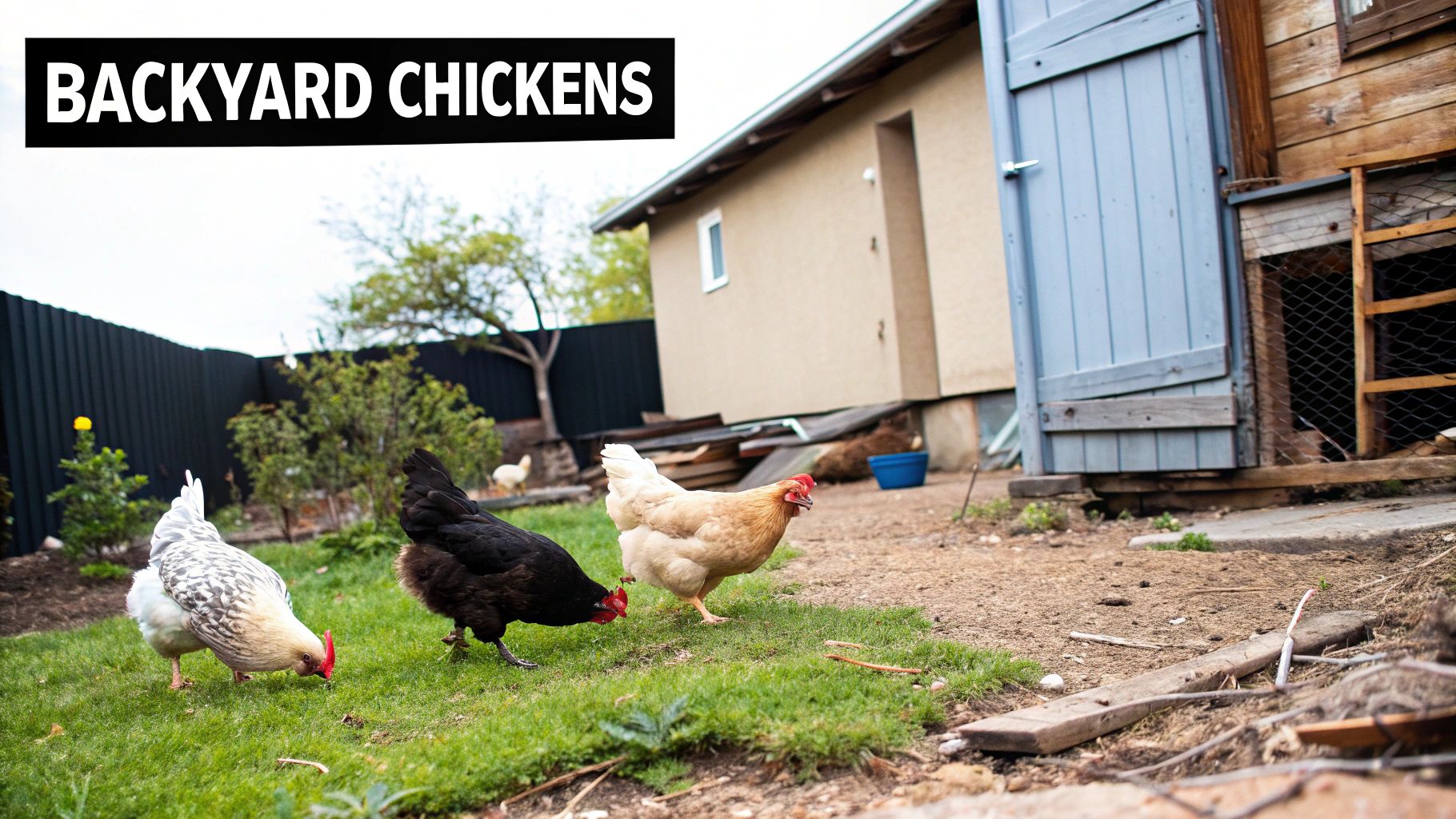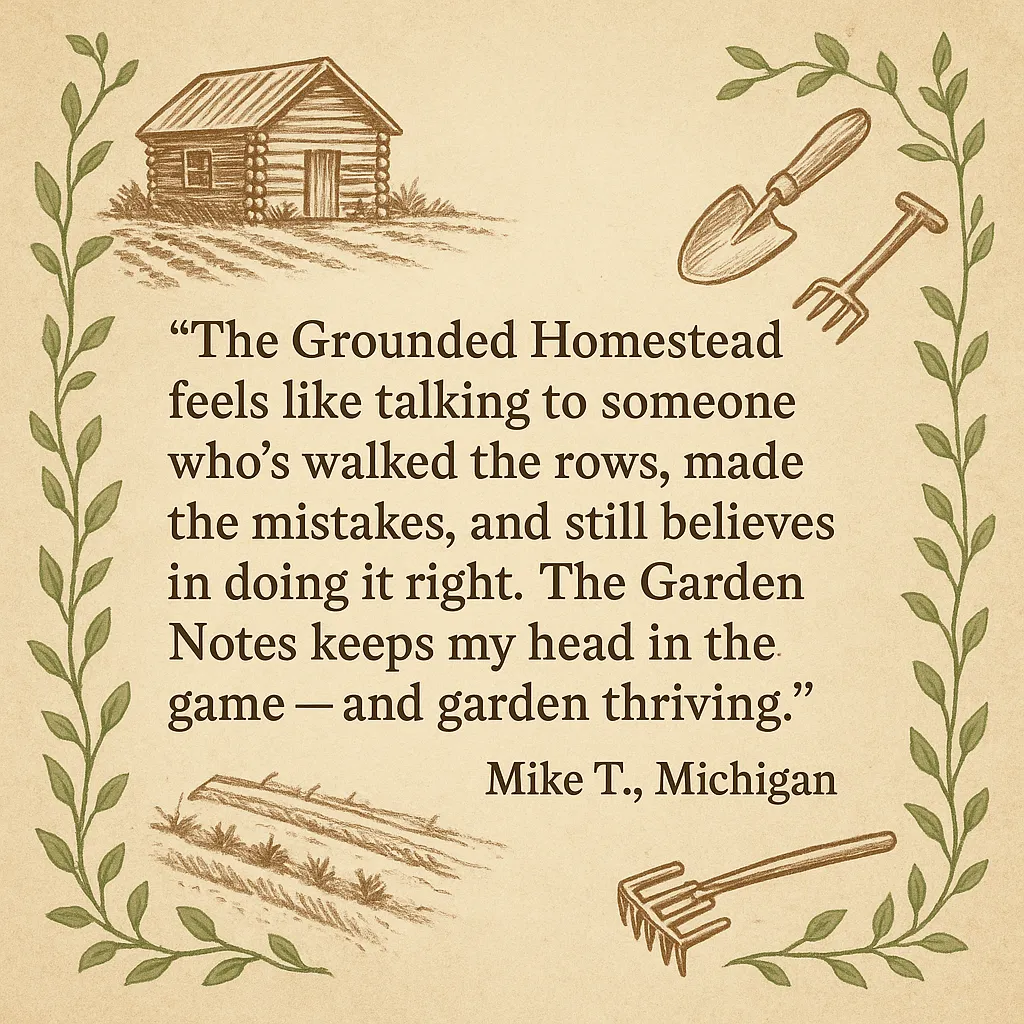
Homesteading for Beginners: Your Easy Path to Self-Sufficient Living
Homesteading for Beginners: Your Easy Path to Self-Sufficient Living
Homesteading for Beginners: Your Easy Path to Self-Sufficient Living
Beyond the Instagram Fantasy: What Homesteading Actually Looks Like
Designing Your Space Like a Seasoned Homesteader
Growing Food That Actually Feeds Your Family
Adding Animals Without Losing Your Sanity
Building What You Actually Need (Without Going Broke)
Why Modern Families Are Choosing the Homestead Life
Beyond the Instagram Fantasy: What Homesteading Actually Looks Like

It’s easy to get lost scrolling through pictures of perfect gardens, colorful egg baskets, and happy families snuggling baby goats. Those moments are absolutely part of the experience, but they're just the highlight reel. They don't capture the muddy boots, the crop that failed, the sore muscles, or the steep learning curve that comes with starting a homestead. The reality is, this life is less about a pretty picture and more about grit, resilience, and changing how you think about success.
One of the biggest adjustments for newcomers is getting in sync with nature’s timeline. We're all used to getting things done quickly. But on a homestead, you operate on a seasonal clock. You can't speed up a tomato plant or tell a broody hen to hurry up. Shifting from a mindset of instant gratification to one of patient observation is everything. Many beginners feel defeated in the first six months because they expect steady, predictable progress. A successful homesteader learns to see nature as a partner, not an employee you can boss around.
The Reality of Self-Sufficiency
The idea of feeding your family entirely from your own land is a beautiful one, but it’s a long-term goal, not something you’ll achieve in your first year. Most new homesteaders are taken aback by how much work it takes to produce even a small amount of their own food. It’s a journey of building skills one year at a time. For example, getting to a place of real self-sufficiency with food and livestock takes time. Recent data shows that 80% of homesteads under two years old produced 25% or less of their family's food.
But here's the good news: that number gets much better with experience. After a decade, homesteaders reported producing around 70% of their food on average. You can dive deeper into this journey in this fascinating breakdown of homesteader self-sufficiency. This isn’t to discourage you; it’s about setting a pace that you can stick with. Your first few years are for learning, not for mastering everything at once.
Mindset Shifts for Thriving, Not Just Surviving
The people who truly flourish in this lifestyle don't just learn to garden or raise chickens; they learn to change their way of thinking. Here are a few mental adjustments that separate the successful homesteaders from those who burn out:
Embrace Failure as Data: Your first squash harvest might get wiped out by vine borers. A batch of canned green beans might not seal correctly. Instead of seeing these as failures, treat them as valuable information. You’ve just learned what doesn’t work on your specific land, in your climate. This is how you build the practical knowledge that leads to future wins.
Redefine "Productivity": A productive day isn’t always about a massive harvest. Sometimes, it’s spending two hours mending a fence, watching for pests in the garden, or just sitting down to plan for the next season. Celebrate the small, foundational victories, not just the big ones that look good in a photo.
Focus on Systems, Not Just Tasks: Instead of just "feeding the chickens," think about creating a system that makes feeding them easier and more efficient. Could a different feeder cut down on waste? Can you move their waterer closer to the spigot? Thinking in systems is what saves you time and energy—your most valuable resources—in the long run.
Designing Your Space Like a Seasoned Homesteader
Before you ever break ground on a garden or bring home your first chicken, the most important work happens with a notepad and a pair of boots. Walking your land and planning your layout is the foundation of a successful homestead, whether you’re working with a quarter-acre lot or sprawling fields. This is where you learn to think like a seasoned homesteader—in terms of flow, efficiency, and how the sun, water, and wind move across your property.
Skipping this part is a classic beginner mistake that can lead to years of extra work and frustration. Imagine hauling heavy water buckets across your entire property twice a day or realizing your brand-new garden is shaded by the house precisely when it needs the most sun. These are the kinds of headaches a thoughtful design prevents. A great layout isn’t just about making things look pretty; it’s about making your daily life easier by working with nature, not against it.
Reading Your Land: Sun, Water, and Soil

Your first task in planning a homestead is to see your property not as a blank slate, but as a living system with its own patterns. Start by mapping your sunlight. Watch where the sun hits at different times of day and throughout the seasons. The best spot for a vegetable garden is almost always one that gets at least six to eight hours of direct sun, especially morning sun, which helps dry dew off leaves and prevent disease.
Next, get to know your water. Where does rain pool after a storm? Where does it run off? This dictates where you should—and shouldn't—place structures and gardens. A chicken coop placed in a low, damp area is a recipe for health problems, while that same spot might be perfect for water-loving plants like elderberries or willows. You don’t need fancy equipment; simple observation during a heavy rain is your best tool.
Finally, get your hands dirty and learn about your soil. A simple home soil test kit can tell you about its pH and nutrient composition. Is it heavy clay that holds water, sandy soil that drains instantly, or rich, dark loam? This information will guide what you can grow successfully and what amendments you'll need. For example, planning to grow lettuce? Some varieties are remarkably adaptable, and you can even grow lettuce anywhere with a few beginner-friendly tricks. Knowing your soil from the start saves you the heartache of planting crops that are destined to struggle.
Before you start planting, take five minutes to learn what your soil is telling you. This easy soil test kit helps you know exactly what nutrients you’re working with—no guesswork, just better gardens.
The Power of Zoning for Efficiency
One of the most practical concepts in homestead design is zoning. This isn't about regulations; it's about organizing your space based on how often you need to visit and tend to different areas. Think of your property in concentric circles or zones radiating out from your house.
To help you visualize this, here’s a breakdown of how you might allocate space. The right balance depends on your goals, but these percentages offer a solid starting point for different property sizes.

This table shows that as property size increases, the percentage dedicated to food production typically grows, while the living space becomes a smaller part of the whole. This reflects the shift from a backyard garden to a more self-sufficient system.
Let’s look at how this zoning concept works in practice:
Zone 1:
This is the area you visit daily, sometimes multiple times. It should be closest to your house. Think of your kitchen herb garden or a small greenhouse for starting seeds.
Zone 2: These are spots you visit once or twice a day. The chicken coop, main vegetable garden, and compost bins belong here. You want them close enough for convenience but far enough away to manage smells and pests.
Zone 3: Visited a few times a week, this zone is for things like a small orchard, berry patches, or pastures for larger livestock like goats or sheep.
Zone 4: This is your semi-wild zone, visited weekly or less. It might be a woodlot for firewood, a foraging area for wild mushrooms, or a spot for hunting.
Zone 5: The final zone is pure wilderness. It's the part of your land you leave unmanaged to support local wildlife and natural ecosystems.
By placing high-traffic areas like the chicken coop and main garden (Zone 2) close to the house (Zone 1), you drastically cut down on the energy spent on daily chores. A seasoned homesteader knows that saving an extra 50 yards on a water run adds up to miles over a year. This strategic layout creates an efficient flow that saves you countless hours and thousands of steps, turning daily tasks from exhausting sprints into manageable routines.
Growing Food That Actually Feeds Your Family

This is where the real work—and the real reward—of homesteading begins. You can plan all you want, but nothing happens until you get your hands dirty and put seeds in the ground. Growing food is the heart of this lifestyle, and success isn't about having some magical "green thumb." It’s about making smart choices that fit your land, your schedule, and your family's needs. The goal isn't a picture-perfect garden; it's a productive patch of earth that genuinely lightens your grocery bill.
So many new gardeners get overwhelmed because they try to grow a little bit of everything. A better way to start is by focusing on high-value, high-yield crops. Think about what your family loves to eat and what costs a fortune at the store. A single zucchini plant can bury you in squash all summer, while a small bed of good salad greens can easily save you $10 to $15 a week. It’s all about getting the best return on your investment of time and energy.
Choosing Your Workhorse Crops

To make a noticeable difference in your food supply, you have to be selective. Some plants are just plain easier and more productive for beginners. You’re aiming to grow calories and nutrients, not just interesting novelties. Here are a few reliable performers that deliver time and again.
Potatoes: These are incredibly calorie-dense and simple to grow in bags, raised beds, or even straw bales. A small 10x10 foot plot can yield 50-100 pounds of potatoes, which will keep for months in a cool, dark spot.
Green Beans (Bush Variety): Forget the hassle of building elaborate trellises for pole beans. Bush beans are compact and produce a big harvest all at once, which is perfect for a big canning or freezing day.
Winter Squash: Varieties like butternut and spaghetti squash are famously productive. Their hard skins mean they can be stored for 4-6 months without any special equipment, feeding you well into the winter.
Garlic: Plant the cloves in the fall and pretty much forget about them until next summer. Garlic takes up very little room and is a core ingredient in so many meals.
These crops are the backbone of a practical food garden. They’re relatively low-maintenance, store well, and give you a lot of food from a small space.
Thinking Beyond Annuals: The Perennial Advantage
While annual vegetables are the foundation of most gardens, adding perennials is a smart move for long-term food security. This idea is catching on, with perennial food gardens becoming a major gardening trend. These are the plants you put in the ground once, and they reward you with food for years with very little work. Think apple trees, raspberry bushes, and hardy staples like rhubarb. If you're curious about this sustainable approach, you can explore the top 2025 gardening trends.
A fantastic and easy perennial for any new homesteader is strawberries. They’re simple to get started, they spread to fill a patch on their own, and they deliver a delicious harvest year after year. For a great, low-effort fruit that keeps on giving, check out our guide on how to start with strawberries, a garden fruit that grows back.
Smart Systems for a Bigger Harvest
Growing more food isn't just about planting more seeds. It’s about using clever techniques to get the most out of your space and extend your growing season.
Succession planting is a game-changing strategy. Instead of planting all your lettuce at once, sow a new short row every couple of weeks. This gives you a steady supply instead of a giant pile you can't possibly eat. Once your garlic is harvested in mid-summer, that spot doesn't sit empty—it immediately gets planted with a fall crop like carrots or kale.
Season extension techniques can add months to your harvest window. A simple cold frame—basically a bottomless box with a clear lid—can shield your greens from early and late frosts. Even just a thick layer of mulch can protect root vegetables like carrots and parsnips in the ground, letting you pull them up for a fresh meal in the middle of winter. These low-cost tricks make a massive difference, turning your garden into a reliable, nearly year-round food source.
Adding Animals Without Losing Your Sanity
Bringing animals onto the homestead is a huge milestone. It’s the moment your property truly feels alive, shifting from a quiet garden into a dynamic, living ecosystem. But it’s also a step that requires careful thought and honest self-assessment. The jump from plants to livestock can be steep, as animals demand daily care, financial investment, and a different level of responsibility. Choosing the right animals for your space, budget, and experience level is the key to making this a joyful addition rather than a source of constant stress.
A common pitfall for new homesteaders is starting too big. The romance of a milk cow or a flock of sheep is powerful, but the reality involves significant infrastructure, feed costs, and medical knowledge. The wisest approach is to start small, learn the fundamentals of animal husbandry, and build your confidence. Chickens are the classic gateway animal for a reason—they are relatively inexpensive, require minimal space, and provide a quick, tangible return in the form of fresh eggs.
Choosing Your First Livestock
When you're deciding which animals to bring home, it's not just about what you want to get from them (eggs, meat, milk); it's about what you can realistically provide. Every animal has its own set of needs for housing, food, and social interaction. Before you commit, you must also investigate your local zoning laws and any neighborhood covenants. Discovering your property isn't zoned for chickens after you’ve built a coop is a heartbreaking and expensive mistake.
Your climate is another huge factor. Hardy chicken breeds like Wyandottes or Buff Orpingtons will fare much better in cold winters than more delicate breeds. Similarly, Nigerian Dwarf goats are more adaptable to various climates than some larger dairy breeds. Consider your available space carefully. While chickens can thrive in a small backyard with a secure run, larger animals like goats or pigs need sturdy fencing and more room to roam to stay healthy and happy.
To help you weigh your options, here’s a look at how some of the most popular starter animals stack up against each other.

This table makes it clear why chickens are such a popular first choice—their low cost and time commitment make them an accessible entry point. Rabbits and quail are also excellent small-space options. Goats, while incredibly rewarding, represent a significant jump in cost, space, and daily effort.
The Real Costs and Commitments
The purchase price of an animal is often the smallest part of the total investment. It’s the ongoing costs that you need to budget for. Here’s a quick reality check on what's involved:
Housing: A secure, predator-proof coop or shelter is non-negotiable. This can be a significant upfront cost unless you're a skilled builder with access to reclaimed materials.
Fencing: This is crucial for both keeping your animals in and predators out. The cost of fencing can easily run into hundreds or even thousands of dollars, depending on the type and area you need to enclose.
Feed: Feed will be your largest recurring expense. Research feed costs in your area and calculate how much your chosen animals will consume each month. For a small flock of 6-8 chickens, you can expect to spend $20-$40 per month on feed.
Veterinary Care: You need a plan for when things go wrong. Find a local vet who treats farm animals before you have an emergency. Set aside a small emergency fund, as an unexpected vet visit can be costly.
Beyond the financial side, there's the time commitment. Animals need care every single day, twice a day, without exception. There are no weekends off or sleeping in when animals are depending on you for food, fresh water, and a clean living space. This daily rhythm is one of the most rewarding aspects of homesteading, but it’s a significant lifestyle change that you need to be fully prepared for.
Building What You Actually Need (Without Going Broke)

The word "infrastructure" sounds big and intimidating, doesn't it? It can bring to mind massive barns and professionally outfitted workshops. But on a new homestead, your first structures don't need to be grand. They just need to work. Smart, simple structures can make your daily chores feel smoother, but overbuilding is a classic beginner trap that drains your bank account and your spirit. You don't have to be a master carpenter to build the essential spaces you'll need.
The trick is to focus on what problem you need to solve today, not ten years from now. Are you bringing home your first flock of chickens? Then your priority is a solid, predator-proof coop. Is your garden suddenly overwhelming you with zucchini? You need a clean, practical spot to start canning. If you approach your building projects as a series of small, necessary steps, you’ll build momentum without going into debt.
Prioritizing Your First Projects
When you’re just starting, every dollar and every hour is precious. It's easy to get sidetracked by "nice-to-have" projects when the "must-haves" are still on the to-do list. The most successful homesteaders I know built their places gradually, letting the real needs of their land and lifestyle guide what came next.
For a first-year homesteader, a practical priority list usually looks something like this:
A Secure Animal Shelter: If animals are part of your plan, their housing comes first. This isn't just a box to keep them out of the rain; it needs to be predator-proof, well-ventilated, and easy to clean. A simple A-frame chicken tractor or a three-sided goat shelter made with cattle panels and a heavy-duty tarp is a great start.
A Functional Tool Shed: You don’t need a giant workshop right away, but you do need a dry, organized spot for your tools. Leaving shovels, rakes, and especially power tools out in the elements will ruin them faster than you can imagine. A small, simple shed protects your investment and keeps everything where you can find it.
An Efficient Food Processing Area: This doesn’t have to be a fancy, dedicated “canning kitchen.” It can be as simple as a sturdy table set up in the garage or a section of your kitchen counter that’s always kept clear and ready for action. The goal is a workspace that makes preserving your harvest feel organized, not chaotic.
DIY vs. Hiring It Out: Making the Call
The "do-it-yourself" mindset is a core part of homesteading for beginners, but it’s crucial to be honest about your skills, your time, and the tools you actually own. Building a few raised garden beds is a perfect weekend DIY project. Pouring a concrete slab for a large shed, on the other hand, might be a job for the pros if you’ve never mixed concrete before.
Before you swing a hammer, make a quick call to your local planning or zoning office. Many areas have rules about the size and type of structures you can build without a permit. That phone call can save you from a huge headache and a potential fine down the road. Any project that requires a permit—like something involving complex electrical or plumbing work—is often a good sign to hire a professional. A failed DIY electrical job isn't just a waste of money—it's a serious safety hazard. Weigh the cost of hiring help against the value of your time and the peace of mind that comes from a job done right.
Why Modern Families Are Choosing the Homestead Life
There's a quiet but steady movement taking root across the country. Families are swapping bustling city streets and overbooked calendars for the grounded, intentional pace of homestead life. This isn't just about running from the nine-to-five; it's a conscious decision to build a life with more meaning, connection, and real-world resilience. For many, it begins with the simple urge to know exactly where their food comes from.
That desire for a more tangible lifestyle often walks hand-in-hand with a search for stronger family connections. On a homestead, work isn't something that happens "out there"—it’s a shared family effort. Kids learn responsibility and practical skills not from a screen, but by collecting eggs, weeding the garden, or helping mend a fence. These shared tasks create a unique sense of teamwork and reliance that's hard to find when everyone is on a separate schedule. The whole family learns to solve problems together and celebrate real successes, like the first ripe tomato or a full basket of eggs.
Redefining Work and Wealth
Homesteading offers a different picture of a "rich" life. It shifts the focus from purely financial success to the wealth of skills, time, and health. Many families find this path brings surprising career flexibility. With the growth of remote work, it's more possible than ever to keep a professional job while also tending to a small farm. This mix of modern work and traditional living allows families to build a secure, self-reliant home base without giving up their income. You can read about how one family made this work in The Grounded Homestead’s beginner journey.
This isn't a fringe trend; it's a growing response to the pressures of modern life. The global rise of homesteading for beginners among younger generations points to a deep want for sustainability, simplicity, and a closer tie to the natural world. Rising food costs and inflation have only made a more self-sufficient life more appealing. For many, growing a garden or raising a few chickens is a practical step toward taking control of their family's future and well-being. To get a better sense of this cultural shift, you can explore detailed insights on the modern homesteading movement.
Finding Community and Support
While homesteading builds self-reliance, it's anything but a life of isolation. In reality, it often leads to deeper community bonds. Whether it’s swapping garden produce with a neighbor, joining a local co-op, or sharing tips in an online forum, homesteaders are experts at building support networks. This community is key for working through challenges and sharing knowledge. For today's families, this blend of independence and community is the perfect recipe for a fulfilling, resilient life.
Your Practical First-Year Action Plan

Success in homesteading isn’t about one huge, life-altering push. It's about stacking small, intentional wins day after day. A practical action plan for your first year helps you build momentum without burning out. Instead of trying to tackle everything at once, you’ll focus on what makes sense for each season. This approach gives you room to learn and adapt, turning big dreams into manageable steps.
Seasonal Milestones for Your First Year
Breaking down your first year by season creates a natural rhythm and keeps the overwhelm at bay. Remember, this year is for building foundational skills, not achieving total self-sufficiency overnight. Think of it as laying the groundwork.
Spring (Months 1-3): This is all about getting started. Focus on your first, small garden. Build a couple of raised beds, get a simple compost system going, and if you're planning on chickens, now is the time to order your first batch of chicks. The key is to start small—a 10x10 foot garden is more than enough to learn the ropes.
Summer (Months 4-6): Now it's about tending and learning. Keep up with your garden, figure out how to manage pests naturally, and celebrate your first small harvests. If you got chicks, they’ll likely start laying their first eggs. This is also the perfect time to tackle your first preservation skill, like learning to can or freeze green beans.
Fall (Months 7-9): The focus shifts to preserving your harvest and preparing for the colder months. Gather your long-storing crops like winter squash and potatoes. Plant a fall garden with cool-weather lovers like garlic and kale. It’s also time to give the chicken coop a thorough cleaning and prepare it for winter.
Winter (Months 10-12): This is your season for planning and skill-building. As the outdoor work slows, pull out your garden notes. What worked? What was a total flop? Use this downtime to research your next big project, repair your tools, or master an indoor skill like baking your own sourdough bread.
Tracking Progress and Staying Motivated
True motivation comes from seeing real progress, not just dreaming about it. Instead of setting vague goals, create clear, measurable benchmarks that show you how far you’ve come.
This historical image shows homesteaders proving up their claim, a testament to the long tradition of building a life from the land.
Just as early homesteaders had to document their progress for legal reasons, you should document yours for motivation. Keeping a simple journal or using a whiteboard in the shed to track harvests and project completions gives you tangible proof of your hard work. Seeing those small victories add up is what will fuel you for the journey ahead.
Video Summaries of this issue:
As always, the tools and supplies I mention are the same ones I rely on here at The Grounded Homestead. Some are affiliate links, which means I may earn a small commission—at no extra cost to you—but every recommendation is based on real use and trust.
Ready to dig in and start your journey? Our weekly newsletter, "Garden Notes," is packed with tips and stories to guide you every step of the way. Learn more and join our community at The Grounded Homestead.



Facebook
Instagram
X
Youtube